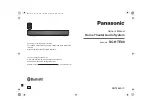
USING THE M-20 CONTROL FUNCTIONS:
The M-20 controls are designed for utility and repeatability under varying conditions and
make only subtle impact on the basic character and accuracy of the speaker. We encourage
you to experiment with fine tuning the system to your particular requirements.
POWER INDICATORS:
Two LED’s are located to the immediate left of the power switch on the M-20 Control Amplifier:.
The top (green) LED lights up indicating there is AC power to the amplifier and the POWER SWITCH is turned
“On”.
The lower (red) LED indicates a clipping or overload condition. Occasional flashing of this
indicator is a gentle warning you are reaching the system’s limits. If the red LED glows continually,
severe clipping is occurring and the input signal or system gain should be reduced to avoid the risk
of possible system damage.
SYSTEM STATUS DISPLAY:
Located in the center of the front panel, a unique system status display informs you of the
operating state of your system. Three small LED’s(green for average SPL, yellow for AC line voltage,
and blue for heat sink temperature)respond to your setting the square MODE switch to the right of
the System Status Display to the desired mode.
SPL: This is a reading of the long term average sound pressure level calibrated at 2 meters from the M-20
monitor, and derived from the amplifier output voltage. Peak sound levels are ignored. The readout is
designed to report overall listening levels and to help realize consistent monitoring from hour to hour,
session to session and room to room. Levels under 68 dB are shown as “00”; levels over 120 dB are
shown as “HI”. Since monitoring level has a profound influence on the perception of sonics,
periodically checking SPL helps to assure consistent results.
VAC: This is a reading of the AC power line voltage being supplied to the M-20. It is useful for assuring
that power conditions are correct and sufficient for all the equipment on the circuit. Sustained readings
below 110 V may limit your maximum output levels, and could indicate that the AC circuit is
overloaded. Continuous readings above 125 V indicate an AC circuit problem, which could lead to
amplifier failure.
TMP: This is a reading of the output heat sink temperature in Centigrade. Typically, you should
expect this to run between 40°C and 60°C, depending on listening and ambient conditions. If you
find that your Control Amplifier unit tends to run hotter than 60°C, it is recommended that you improve
the ventilation around it. The M-20 Control Amplifier contains a protection circuit that automatically
shuts the amplifier down if the heat sink temperature reaches 100°C.
SENSITIVITY:
This function controls input sensitivity with settings at -10dB, -3dB, +4dB, +11dB and (M)ute to provide
noise-free, consistent gain matching with a wide variety of equipment. The proper setting is the
lowest sensitivity possible (highest dB number) which allows the speaker to reach the maximum
desired output without source clipping. Professional devices typically specify full output at +4dB,
most consumer audio products reach full output at -3dB; most computer sound cards at -10dB. Consult
the owner’s manual of the source device driving to the M-20 Control Amplifier for its output level
specifications and set the SENSITIVITY control accordingly.
Fig. 5 M-20 Control Amplifier Front Panel
M-20
CONTROL
AMPLIFIER


























